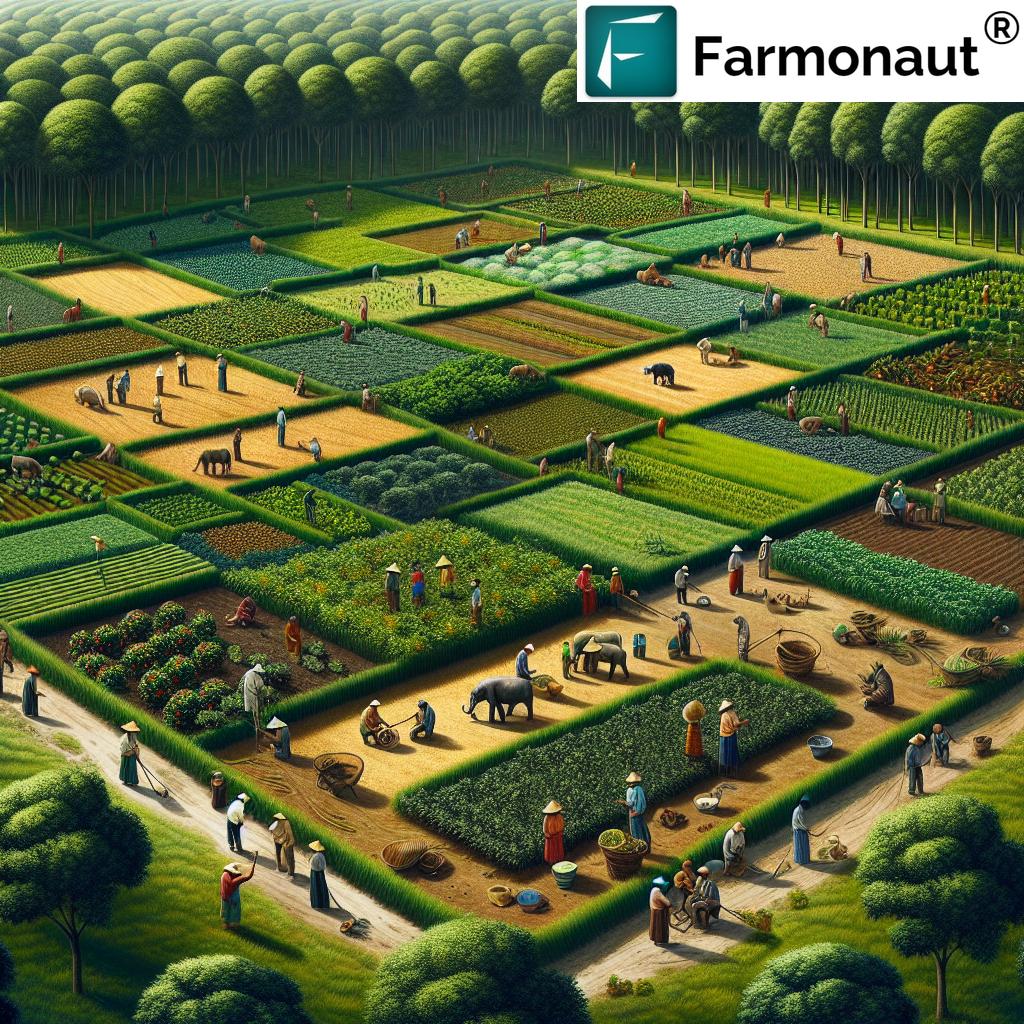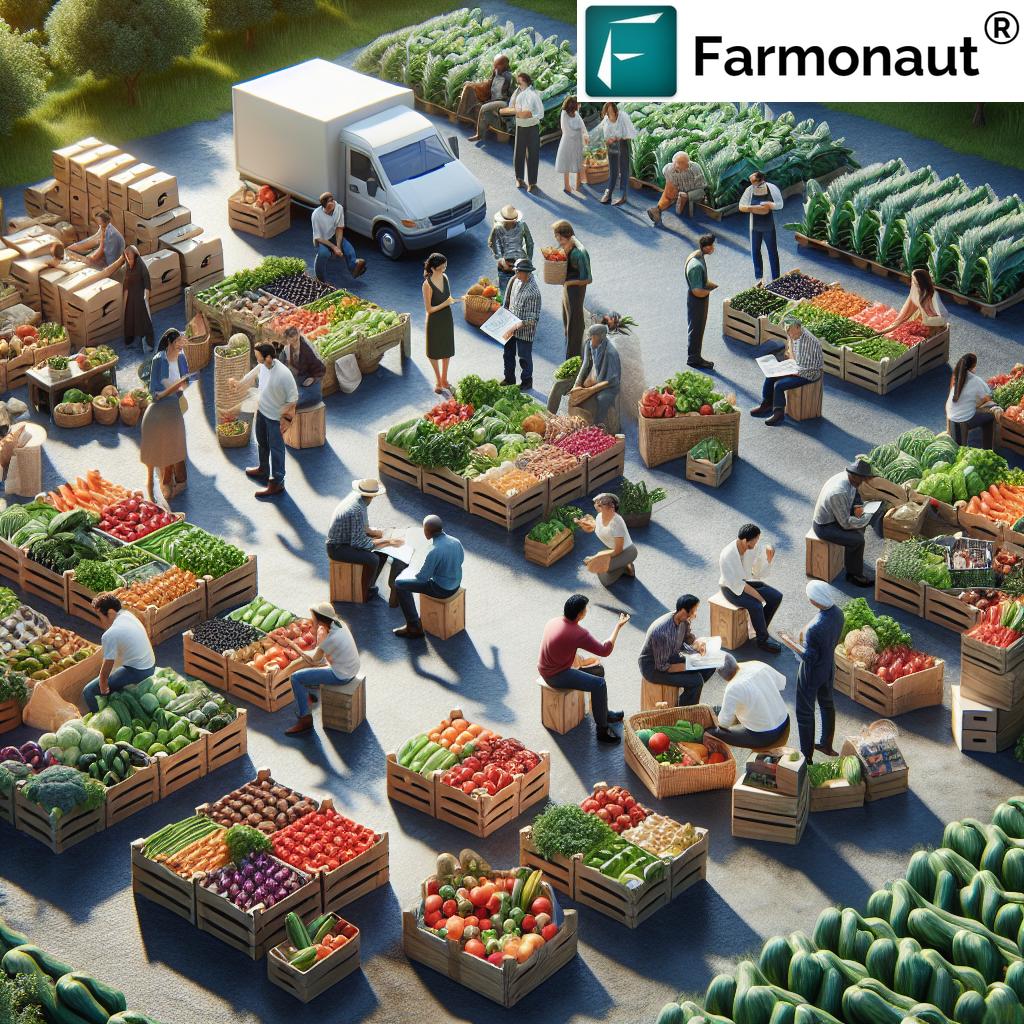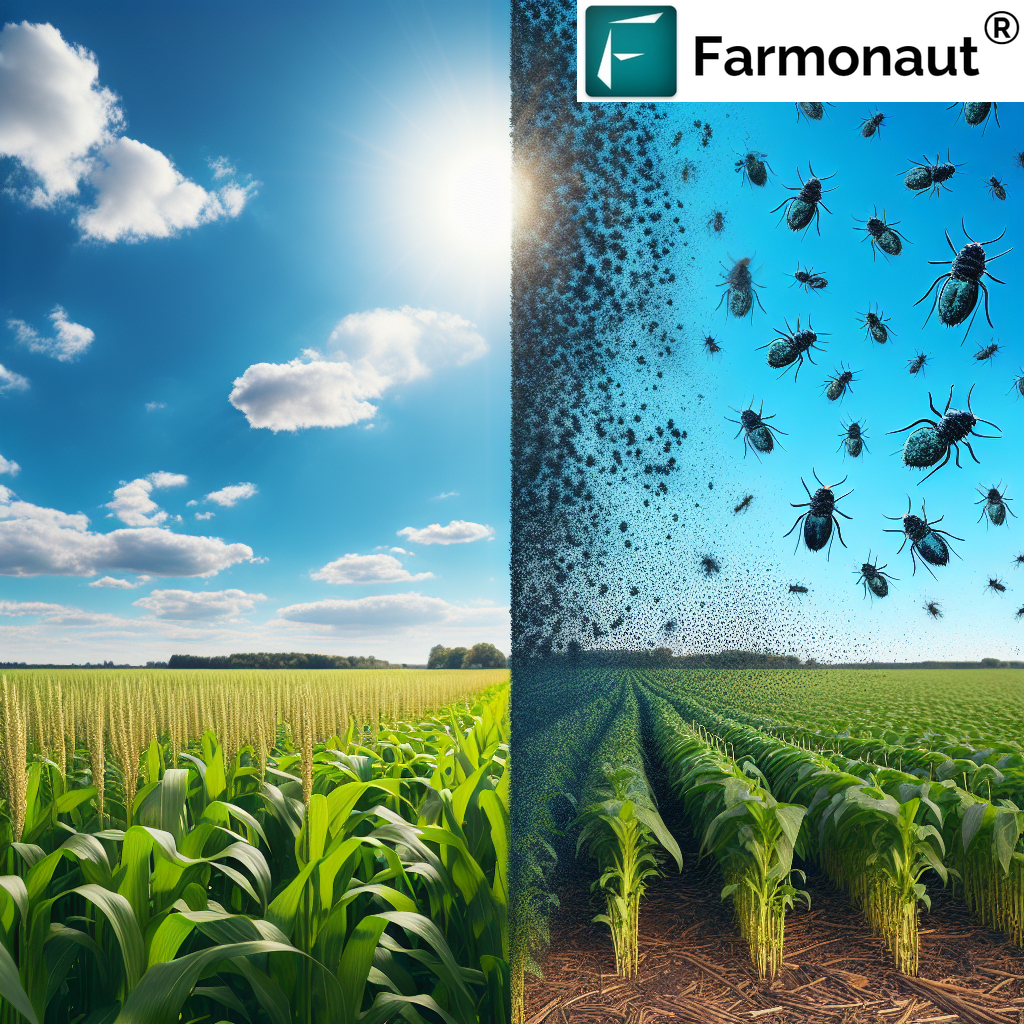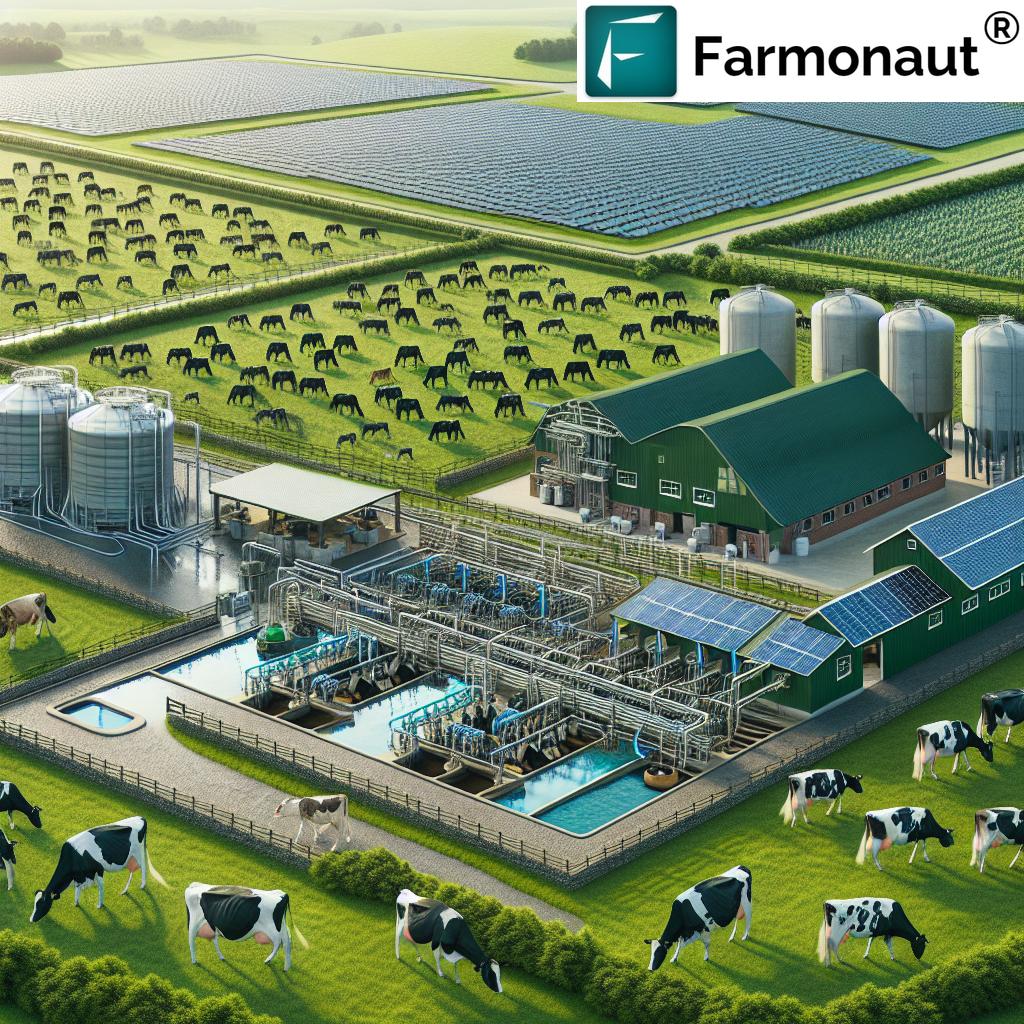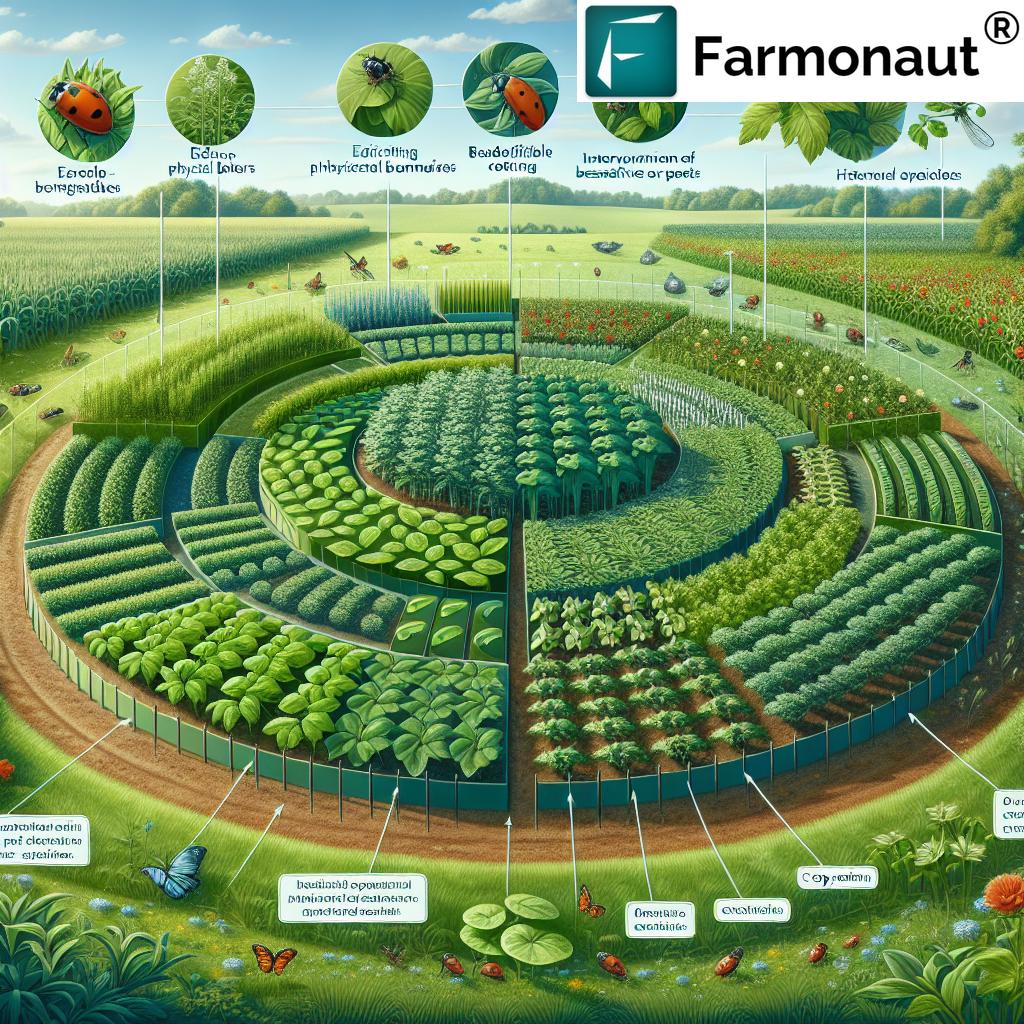“Collaborative farming can increase crop yields by up to 30% through shared resources and sustainable practices.”
Collaboration in Agriculture: 7 Shocking Sustainability Hacks
In today’s fast-evolving agricultural sector, collaboration in agriculture stands out as a transformative approach for driving productivity, sustainability, and community resilience. From collaborative farming practices to knowledge sharing in agriculture and resource pooling, we recognize that working together unlocks new opportunities. This blog will uncover seven sustainability hacks that leverage collaborative agriculture to benefit farmers, communities, and our planet. We’ll delve deep into how models like farmer cooperatives, community supported agriculture (CSA), agroforestry systems, and more, are propelling the new green revolution.
We also unravel the vital role of advanced tools, such as those offered by Farmonaut, in empowering both small and large-scale farmers with access to data-driven insights and affordable precision technologies. Dive in as we explore these powerful sustainability hacks!
Types of Collaboration in Agriculture
Collaboration in agriculture encompasses a broad spectrum of models, each uniquely addressing the need for shared resources, knowledge, and sustainability. Understanding these types sets the stage for effective collaborative farming practices:
- Farmer Cooperatives: Organizations owned and operated by farmers, working together to market products, negotiate better prices, and gain access to shared resources. Examples like Organic Valley and Land O’Lakes have empowered their farmer members, making them more competitive in local and global markets.
- Community-Supported Agriculture (CSA): This model connects consumers directly with local farmers through shares or subscriptions, providing fresh produce while ensuring stability and promoting sustainable practices.
- Agroforestry Practices: Here, crops and trees or pasture are integrated into sustainable polyculture systems, producing timber, fruits, nuts, and more, while enriching biodiversity and improving soil health.
- Silvopasture: Combining trees, forage, and livestock in a diversified system, silvopasture yields multiple income streams and environmental gains such as carbon sequestration.
- Community Forestry: Fosters participatory decision-making in forest management, combining the insights of local communities, government, and NGOs to promote sustainable land use and long-term livelihoods.
Let’s explore how these collaborative models lead to shocking sustainability outcomes for farmers, communities, forestry stakeholders, and beyond.
“Over 60% of farmers report improved resilience to climate change when participating in agricultural knowledge-sharing networks.”
7 Shocking Sustainability Hacks in Collaborative Farming
Let’s unveil seven high-impact sustainability hacks—practical, proven approaches that foster collaboration and ignite positive change in agriculture. These hacks illustrate how collective efforts redefine sustainable and scalable productivity.
1. Forming Farmer Cooperatives for Shared Resources in Farming
Farmer cooperatives are collaborative organizations owned and operated by their members. By pooling resources such as machinery, storage facilities, and marketing capabilities, cooperatives enable members to reduce costs, increase productivity, and negotiate better market prices.
Hack: Form or join a local cooperative to share costs, collectively access technologies, and market produce at favorable prices. This model also simplifies compliance and enhances resource management.
2. Adopting Community Supported Agriculture (CSA) for Market Stability
Community supported agriculture (CSA) connects local farmers directly with consumers who subscribe to regular shares of fresh farm products. This model ensures farmers receive upfront payments, guaranteeing a market for their crops and decreasing post-harvest losses.
Hack: Structure your farm business with a CSA model. Ensure transparent communication with subscribers, and diversify produce to keep offerings attractive season-round.
3. Implementing Agroforestry Systems for Enhanced Biodiversity
Integrating agroforestry practices involves growing trees collaboratively with crops or pasture. This enhances farm ecosystem resilience, enriches soils, provides timber and fruits, sequesters carbon, and supports wildlife habitat.
Hack: Intercrop trees and shrubs with annuals or livestock, fostering a dynamic and sustainable environment that supports long-term farm viability.
4. Practicing Silvopasture for Diversified Income & Environmental Gains
Silvopasture—the integration of trees, forage crops, and livestock—enables diversified revenue, improved land use, and climate mitigation through carbon sequestration.
Hack: Establish managed silvopasture plots by selecting suitable tree and livestock combinations. This produces additional income from timber or nuts while improving soil health.
5. Developing Community Forestry Management Programs
Community forestry management empowers local stakeholders to participate in forest resource decisions, blending traditional knowledge with sustainable management for improved livelihoods and environmental protection.
Hack: Join or initiate community-based forestry projects to coordinate forest restoration, sustainable harvesting, and participatory monitoring.
6. Participatory Technology Development in Agriculture
Participatory technology development in agriculture brings together farmers, researchers, and extension agents to create and refine new farming technologies or practices. This approach ensures practical challenges are addressed and solutions are relevant.
Hack: Engage in farmer-led research groups to experiment with new cultivars or resource-saving technologies. Document observations and adapt systems for continuous improvement.
7. Establishing Agricultural Knowledge-Sharing Networks
Knowledge sharing in agriculture broadens access to best practices, weather patterns, pest management strategies, and market trends—especially essential for building collective resilience to climate variability.
Hack: Participate in peer-to-peer learning events, WhatsApp groups, or digital platforms that facilitate widespread sharing of insights, experiences, and research updates.
Benefits of Collaboration in Agriculture
- Access to Shared Resources: Optimize costs by sharing expensive tools, irrigation systems, and storage with neighbors or cooperative members. (See: worldfarmersorganisation.com)
- Knowledge Sharing in Agriculture: Foster innovation and best practice adoption by sharing experience and data.
- Economies of Scale: Bulk buying of seeds and inputs, coordinated logistics, and powerful collective marketing strategies help decrease per-unit costs.
- Risk Mitigation: Spread risk through product diversification, joint decision-making, and resource pooling, helping communities withstand weather/crop failures or price shocks.
- Enhanced Sustainability: Collaborative models often emphasize regenerative agriculture, promoting biodiversity, soil health, and water conservation.
Comparison Table: Collaborative Practices vs Traditional Approaches
| Collaboration Hack | Description | Estimated Productivity Increase (%) | Estimated Cost Savings (%) | Environmental Impact | Community Benefit |
|---|---|---|---|---|---|
| Farmer Cooperatives | Pooling resources, marketing, and price negotiation among members | 20–30 | 15–25 | Reduces input waste, enables eco-friendly purchases | Stronger collective bargaining, local job creation |
| Community Supported Agriculture (CSA) | Direct, subscription-based sales to local consumers | 10–18 | 8–15 | Reduces food miles and chemical inputs | Strengthens farmer-consumer ties |
| Agroforestry Systems | Integrating trees, crops, and/or livestock | 25–35 | 10–18 | Increases carbon sequestration, enhances biodiversity | Improved ecosystem services, long-term resilience |
| Silvopasture | Combining livestock, forage, & timber production | 18–28 | 12–20 | Reduces soil erosion, improves carbon storage | Creates diverse jobs and learning opportunities |
| Community Forestry Management | Participatory management of local forest resources | 12–16 | 9–14 | Enhanced reforestation/soil conservation | Protects local culture & long-term livelihoods |
| Participatory Technology Development | Co-creating new technologies with farmers | 14–22 | 10–14 | Accelerates adoption of sustainable farming solutions | Builds capacity, fosters empowerment |
| Knowledge-Sharing Networks | Peer-to-peer learning, digital extension services | 10–20 | 5–10 | Improves uptake of climate-smart practices | Increases community adaptive capacity |
Farmonaut: Empowering Sustainable Agriculture Collaboration
In pursuit of maximizing the benefits of collaborative farming practices and sustainability, access to technology-driven insights is critical. This is where Farmonaut offers game-changing solutions for smallholder and large-scale farmers, forestry managers, agribusinesses, and organizations:
- Satellite-Based Crop Health Monitoring: Receive actionable intelligence on crop health, vegetation (NDVI), and soil moisture via satellite images, enabling precise resource allocation and early issue detection for improved agricultural productivity.
-
Jeevn AI Advisory System: Leverage AI-driven real-time advice on weather, irrigation, and crop management to implement cutting-edge sustainable agriculture collaboration strategies.
Discover the Farmonaut Agro Admin App for Large-Scale Farm Management — Streamline multi-plot activities and boost team collaboration with advanced mapping, monitoring, and reporting tools. -
Blockchain Product Traceability: Ensure full transparency throughout supply chains and establish consumer trust.
Explore Product Traceability Solutions — Build secure, verifiable backstories for every agri-product, from seed to shelf. -
Fleet & Resource Management: Optimize logistics, manage field operations, and reduce costs by effectively tracking farm vehicles and assets.
See Fleet Management Capabilities — Cut fuel usage, prevent downtime, and monitor machinery across widespread locations. -
Carbon Footprinting: Monitor and minimize your farm or plantation’s carbon emissions to support certification and environmental compliance.
Learn More About Carbon Footprinting Tools — Take control of your climate impact with granular, real-time reporting. -
Crop Loan and Insurance Verification: Use satellite verification to access fair credit and insurance coverage while accelerating claim processes and supporting sustainable investment.
Facilitate Crop Loan & Insurance Approvals — Improve financial inclusion for all farmers. -
Farmonaut API: Integrate multispectral satellite and weather data into your own systems for organization-wide decision-making and analytics.
Access Farmonaut API | API Developer Docs
All these solutions are delivered through a mobile-responsive platform, available as Android, iOS, and web apps, ensuring seamless and affordable precision agriculture for every farm, forestry group, and community.
Challenges in Collaborative Agriculture
- Cultural and Social Barriers: Diverse traditions, risks, or communication issues can affect group cohesion in collaborative farming.
- Legal and Regulatory Complexity: Formal agreements and compliance can be challenging across different entities or regions.
- Resource and Benefit Distribution: Ensuring fairness in access to land, profits, and decision-making requires trust and clear systems.
- Management and Coordination: Success relies on adept leadership, conflict resolution, and consistent monitoring.
- Adopting New Technology: Digital tools and precision monitoring (such as with Farmonaut) may require upskilling and internet access in rural areas.
Overcoming these hurdles will ensure more sustainable, prosperous agricultural communities.
Implementing Collaborative Practices Effectively
- Identify Common Goals: Begin by agreeing on shared objectives—such as boosting productivity, reducing costs, or adopting sustainable practices.
- Establish Clear Legal Agreements: Outline roles, resource-sharing, and dispute mechanisms. Written agreements foster accountability and transparency.
- Promote Open Communication: Use regular meetings, digital groups, or advisory platforms (such as Farmonaut) to facilitate updates and collaborative decision-making.
- Provide Ongoing Training: Access continuous education on new technologies, sustainable farming systems, and regulatory changes.
- Monitor and Evaluate: Set clear benchmarks and adapt approaches based on feedback and measurable outcomes.
Combining these steps with technology platforms like Farmonaut ensures collaborative frameworks are scalable, resilient, and future-proof.
FAQ: Collaboration in Agriculture
What is collaborative farming?
Collaborative farming is a strategic approach where individuals or groups—such as farmers, communities, or organizations—work together to achieve mutual benefits. This can include sharing land, technology, knowledge, or market access.
How does knowledge sharing in agriculture improve resilience?
Sharing expertise, research, and local best practices helps communities adapt to changing weather patterns, market volatility, and emerging pests/diseases, improving overall farm resilience.
How can we start a local farmer cooperative?
Organize interested members, outline shared objectives, register a legal entity (if required in your region), develop formal agreements, and engage regularly to coordinate activities.
What technology does Farmonaut provide for collaborative agriculture?
Farmonaut offers affordable, satellite-based farm monitoring, AI advisory, blockchain traceability, fleet and carbon management tools, and flexible APIs for scaling sustainable agriculture collaboration.
Are there digital tools to support participatory technology development in agriculture?
Yes! Digital platforms, mobile apps, and satellite imagery—such as those from Farmonaut—help document local research, coordinate group learning, and track the success of new practices.
Get Started: Farmonaut Apps & Solutions
Ready to bring collaborative, sustainable farming to your fields?
Choose the Farmonaut app platform that fits your workflow:
Ready to improve agricultural productivity through collaboration?
-
Crop Plantation, Forest, and Advisory tools
— Centralize activities, gain site-specific insights, and coordinate better with your group or community. -
Product Traceability Solutions
— Ensure your collaborative produce wins consumer trust through transparent, blockchain-based verification.
Farmonaut Subscriptions
Choose flexible monthly or annual plans according to your group size, field area, or cooperative needs.
Conclusion
Collaboration in agriculture is more than working together—it’s a strategic pathway to sustainability, increased agricultural productivity, resilient communities, and thriving environments. By embracing collaborative farming practices, knowledge-sharing networks, participatory technology development, and leveraging smart technologies, we ensure future-ready farms that benefit every stakeholder—from individual farmer to entire regions. Join the revolution: harness the power of collective action, advanced insights, and precision agriculture for a greener, more prosperous tomorrow.


